Weeds are an inevitable part of any landscape, competing with desirable plants for nutrients, water, and sunlight. Left unchecked, they can quickly take over garden beds, lawns, and pathways, diminishing the overall health and aesthetics of outdoor spaces. Fortunately, by adopting natural weed prevention and control methods, you can create a thriving, low-maintenance landscape that supports plant health and biodiversity. Implementing sustainable practices not only reduces the need for intervention but also enhances the resilience of your garden or green space over time.
What is a Weed?
A weed is any plant growing where it isn’t wanted. While some may have ecological benefits, they often grow aggressively, spreading quickly and outcompeting desirable plants in your garden or lawn. Weeds tend to establish themselves in disturbed soils, bare patches, and areas where grass or garden plants are weak, making them a persistent challenge in urban landscapes.
Common Weeds in Urban Landscapes
In Metro Vancouver and other urban areas along the West Coast, these are common and recognizable weeds that are frequently encountered:
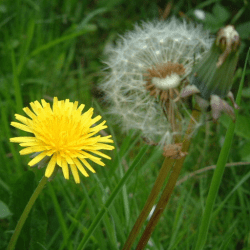 Dandelion Spreads easily by windborne seeds and thrives in lawns and garden beds.
Dandelion Spreads easily by windborne seeds and thrives in lawns and garden beds.
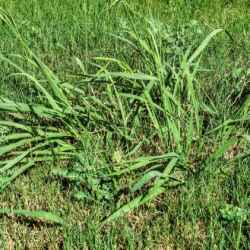 Crabgrass A resilient, fast-growing grass that takes hold in weak or patchy lawns.
Crabgrass A resilient, fast-growing grass that takes hold in weak or patchy lawns.
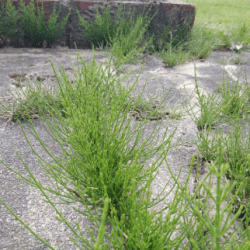 Horsetail A deep-rooted, prehistoric plant that is notoriously difficult to eradicate.
Horsetail A deep-rooted, prehistoric plant that is notoriously difficult to eradicate.
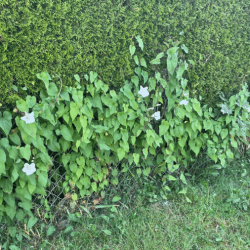 Morning Glory Twining vines that quickly smother other plants and structures.
Morning Glory Twining vines that quickly smother other plants and structures.
Recognizing these weeds early can help you take control before they become overwhelming.
Why It’s Important to Catch Weeds Early
Weeds are easiest to manage when they first emerge. At this stage, their root systems are weak, and they haven’t yet produced seeds, making removal more effective. By regularly inspecting your garden beds, lawn, and pathways for early signs of weeds, you can prevent small patches from turning into large infestations. And the end result will be a more attractive landscape to enjoy over the summer months.
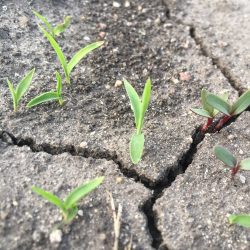
How Quickly Weeds Spread
Once weeds reach the seed stage, they multiply at an alarming rate. A single dandelion can produce up to 2,000 seeds, and some invasive species spread through underground rhizomes (or plant stem that grow underground), making them even harder to control. When weeds go unchecked, they not only take over your landscape and contribute to soil degradation and increased competition for water and nutrients, but also many weed seeds can survive in the soil for years, even decades, meaning complete eradication becomes a bigger challenge.
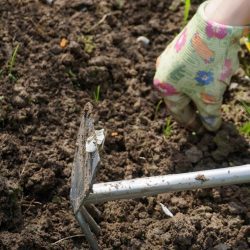
5 Tips for a Weed-Free Landscape
For the greenthumb enthusiasts, here are some tips that can help you achieve that beautiful, weed-free garden.
Tip 1: Mulching is Nature’s Weed Barrier
We talked extensively in last month’s blog about mulch being one of the most effective natural weed preventers. A thick layer of organic mulch, such as wood chips, bark, straw, or shredded leaves, helps block sunlight from reaching weed seeds, preventing them from sprouting. Additionally, mulch retains moisture, improves soil quality, and enhances the aesthetic appeal of garden beds. A mulch layer of 5-10 cm (2-4 inches) is recommended to maximize weed suppression and soil health benefits.
Tip 2: Hand-Weeding a Simple Yet Effective Method
The most traditional method of weed control is simple hand-pulling. The key is to remove weeds while they’re young and before they establish deep roots. Try to pull weeds after rainfall when the soil is moist as this makes it easier to extract the entire root system. Using a trowel or a weeding tool can make the process easier, especially for larger areas. Relying on hand-weeding alone requires regular monitoring and manual removal of weeds as an effective component of integrated weed management. And the best time to start is early spring, so start scanning your garden beds now!
Tip 3: Boiling Water or Vinegar Treatments
If you are a DIY gardener and have a small area that needs attention like for stubborn weeds growing in cracks or along pathways, boiling water is a simple and effective solution. Pouring boiling water directly onto weeds kills them by damaging their cellular structure. Similarly, household vinegar (with at least 5% acetic acid) can be sprayed on weeds to dry them out. Be cautious, as vinegar can also harm surrounding plants, so apply it carefully and directly to the weed you want to remove. If this seems like an arduous task, don’t fret! Our team has the knowledge and equipment to apply acetic acid on large garden and hardscape areas.
Tip 4: Maintaining Healthy Soil to Prevent Weed Growth
Healthy soil supports strong, resilient plants that can outcompete weeds. Regularly adding compost and organic matter improves soil structure and fertility. Conducting soil tests and adjusting pH levels as needed ensures plants thrive while weeds struggle to gain a foothold. If you want to take the extra step, you can have your soil tested, which will give you more accurate information on its contents. Ultimately, soil amendment will promote plant health and reduce weeds.
Tip 5: Proper Lawn Care Practices to Outcompete Weeds
A well-maintained lawn is one of the best defenses against weeds. Mowing at the correct height, watering deeply but infrequently, and aerating the soil help grass grow thick and strong, reducing opportunities for weeds to take hold. Maintaining optimal mowing heights and irrigation schedules according to Metro Vancouver’s Watering Restrictions will support your lawn’s resilience against weeds.
Why Early Weed Control is Key
The best way to keep your landscape weed-free is to prevent infestations before they start. Once weeds mature and go to seed, they can spread aggressively, making them much harder to control. By consistently applying these natural strategies, you’ll spend less time fighting weeds and more time enjoying a healthy, thriving landscape.
By using these natural weed control methods, you can maintain a lush, healthy landscape without relying on harmful chemicals. Not only will this create a safer environment for people and pets, but it will also support biodiversity and sustainability in your outdoor spaces.
If you need expert advice on keeping your landscape weed-free and thriving, contact our team at Para Space Landscaping today!

Comments are closed here.